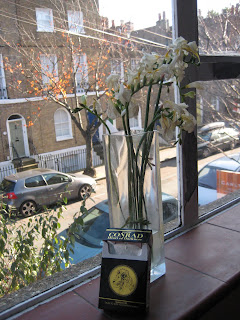 |
| Sid in his new dinner jacket |
Last weekend, Sid’s office invited us to a Christmas party at a country house hotel at the outskirts of London called
Luton Hoo.
Luton Hoo, as a bit of research revealed, is a five-star country manor hotel with 1000 acres of estate land around, an 18 hole golf course, a spa and a history that encompasses over 400 years of aristocratic ownership, parties with the King and Queen in attendance, the movie
Four Weddings and a Funeral, and a resident ghost – the manor’s previous owner, Nicholas Harold Phillips, committed suicide there and is rumoured to haunt the premises. Luton Hoo promised us luxury and adventure wrapped in one.
It turned out to be an adventure alright.
As the main course was being laid out, the waitress stumbled behind Sid as she was serving the guest next to him, coughed an apology and quickly disappeared. In turn, Sid felt a warmth trickle down his back. Our pretty waitress hadn’t just stumbled, she had also managed to pour most of the beef sauce in the plate she held down Sid’s hand-tailored dinner jacket. We had a situation – a 6-ft Californian left with a steak without sauce, a vegetarian Hindu with beef sauce trickling down his dinner jacket and a culprit waitress nowhere to be found.
Sid immediately raised an alarm, and the head waiter – our saviour no 1 called Bobby – took charge. He sent Sid’s jacket to the laundry, got him a replacement for the night and assured us that we would open our eyes the next morning to a freshly laundered, stain-free dinner jacket.
Of course, it wasn’t there the next morning. It was still missing as we were checking out. The night staff at the laundry had left, and the morning staff hadn’t heard of any wayward, beef-stained dinner jackets from the night.
Determined not to lose our cool, we asked them to locate the lost jacket while we took a stroll around the verdant 1000 acres of Luton Hoo’s parkland.
After an hour and half of freezing walk, we got a call from our saviour no 2 called Gareth. The jacket had been located. We rushed back, only to be told that the stain hadn’t come off, the jacket needed to be dry-cleaned, the dry-cleaner would only open on Monday, so could we pretty please leave our address, and they will definitely courier the dry-cleaned jacket by Friday.
In protest, we insisted they dry-clean the pants as well, left our address at the reception, drank the complimentary coffee, and headed back.
It is Friday today, and no courier has come knocking on our doors.
We are now expecting a call from our saviour no 3, who we are sure will be called Nicholas Harold Phillips, Luton Hoo's resident ghost.
***
PS: Yes, of course, I am married to Sean Connery.
 As perhaps Mae West would say - I’ve been thin and I’ve been fat, and believe me, thin is better.
As perhaps Mae West would say - I’ve been thin and I’ve been fat, and believe me, thin is better. 


















